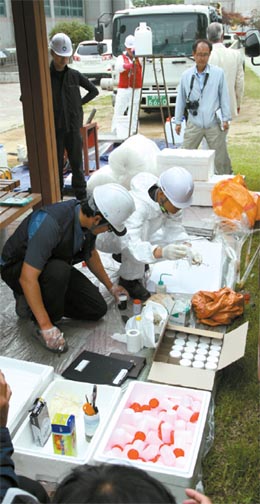Samples of soil taken near U.S. army camp

Members of the Korea-U.S. joint investigative team searching for signs of Agent Orange contamination organize soil samples taken from near the Chilgok Education, Culture and Welfare Center in Chilgok, North Gyeongsang. Samples from inside Camp Carroll will be taken later. [YONHAP]
The joint investigation team, comprised of 13 Korean and five American experts, collected soil samples from 14 locations near but not on the U.S. base, an official said.
The office said it was the first time investigators took soil samples since the team was created on Friday following a claim by U.S. veterans two weeks ago that 250 55-gallon drums of Agent Orange were buried at the camp in 1978.
The team sampled water from four locations near the base on Friday and from six other locations on Monday, the official said. Scheduling of soil samples from inside the camp, currently occupied by U.S. Forces Korea, will likely be decided today at a status of forces agreement meeting.
The Camp Carroll case prompted a cascade of other allegations of illegal disposal of harmful chemicals by USFK, which officials in Seoul and Washington worry will create an anti-American backlash.
Also yesterday, Korea launched its own investigation into former U.S. base Camp Mercer in Bucheon, west of Seoul, the Ministry of National Defense said.
A 13-member team, comprised of civilian and military officials, conducted an on-site investigation at the site to verify claims by former U.S. soldier Ray Bows that USFK buried “hundreds of gallons” of “every imaginable chemical” there between 1963 and 1964, the ministry said. Camp Mercer was returned to Korean control in 1993.
By Moon Gwang-lip [joe@joongang.co.kr]
한글 관련 기사 [중앙일보]
캠프 캐럴 주변 땅속 6m까지 뚫었다
한·미 공동조사단 시추작업 … 1m 단위로 토양 표본 수집
한·미 공동조사단의 미군기지 고엽제 매몰 의혹 조사가 본격화하고 있다.
환경부·한국환경공단·주한미군 관계자 등 20여 명으로 구성된 공동조사단은 31일 경북 칠곡군 왜관읍의 미군기지인 캠프 캐럴 주변 지역에 대한 토양 오염 조사에 나섰다. 고엽제 매몰 의혹이 불거진 이후 토양을 조사하는 것은 이번이 처음이다. 공동조사단은 이날 오전 칠곡군 교육문화회관 뒤쪽에서 시추기를 이용해 토양 시료를 채취했다. 공동조사단은 암반이 나오는 깊이 6m까지 시추공을 뚫었으며 1m 단위로 토양 표본을 수집했다. 시추공을 뚫은 장소는 캠프 캐럴의 남동쪽 담장과 5m가량 떨어진 곳이며 지대가 기지보다 5∼6m 낮다. 고엽제가 묻힌 곳으로 의심되는 D구역과 500m 정도 떨어져 있다. 지하수가 흐르는 방향이어서 고엽제에 오염됐을 경우 쉽게 확인할 수 있는 지점으로 알려져 있다.
토양 시료의 분석작업은 한국환경공단이 맡는다. 수집한 시료에 다이옥신 등 유독물질 들어 있는지 확인해 20일께 결과를 내놓을 예정이다.
공동조사단은 이어 기지 인근 동정천과 낙동강, 기지 밖 배수로 등 6곳에서 하천물도 시료로 확보했다. 다이옥신 등 유독물질에 오염됐는지 가리기 위한 것이다. 환경부 이호중 토양지하수과장은 “고엽제 매몰 추정지와 가까운 곳에서 토양 시료를 채취하는 만큼 지하수나 토양의 오염 여부를 정확하게 알 수 있을 것”이라고 말했다. 공동조사단은 한·미 협의를 거쳐 2일부터 ‘지표투과 레이더(GPR)’를 이용해 고엽제 드럼통이 묻혀 있는지 확인하는 등 기지 내 조사에 나설 방침이다.
이날 할 예정이던 부천시 오정동의 옛 미군부대 ‘캠프 머서’에 대한 민·관·군 공동조사단의 1차 현장조사는 비로 연기됐다. 공동조사단 관계자는 “전자파 탐사의 경우 땅에 빗물이 조금이라도 있으면 정확도가 현저히 떨어진다”며 “향후 날씨 등을 봐가며 일정을 다시 잡을 것”이라고 말했다. 공동조사단은 이날 캠프 머서에서 전자파 탐사 등 물리탐사에 필요한 장비 시연과 함께 향후 조사계획 토론으로 일정을 대신했다.
전자파 탐사는 지표면에서 땅속으로 전자파를 발사해 돌아오는 전자파의 세기와 파장을 분석해 매몰된 물질의 특성을 파악하는 방식이다. 기초조사가 끝난 뒤에는 지하수 수질과 토양 오염 기준 초과 여부, 기타 다이옥신 등 오염물질 발생을 확인하는 개황조사가 이어진다.










with the Korea JoongAng Daily
To write comments, please log in to one of the accounts.
Standards Board Policy (0/250자)